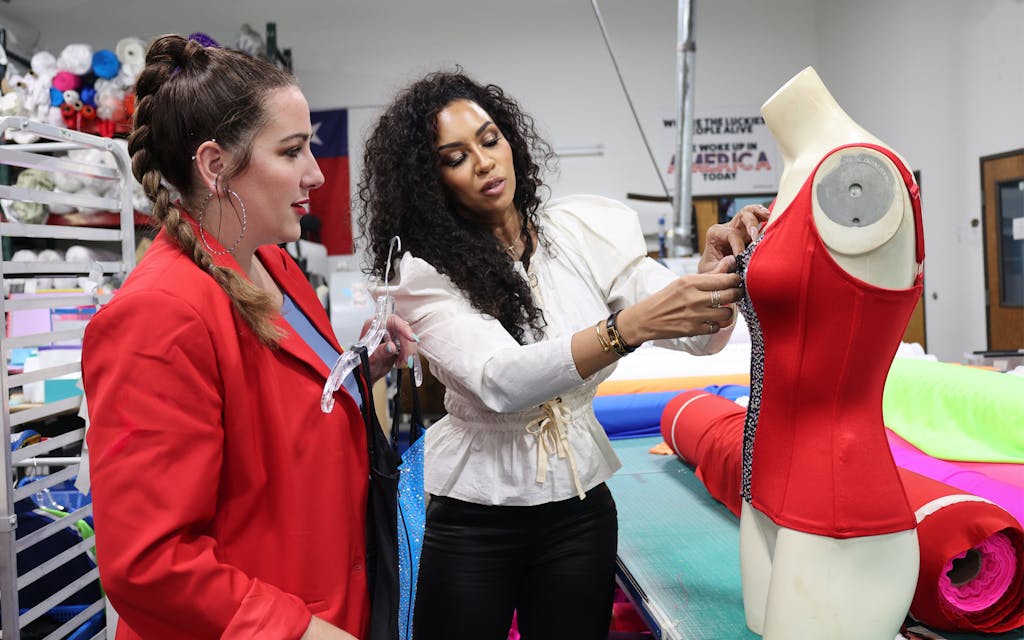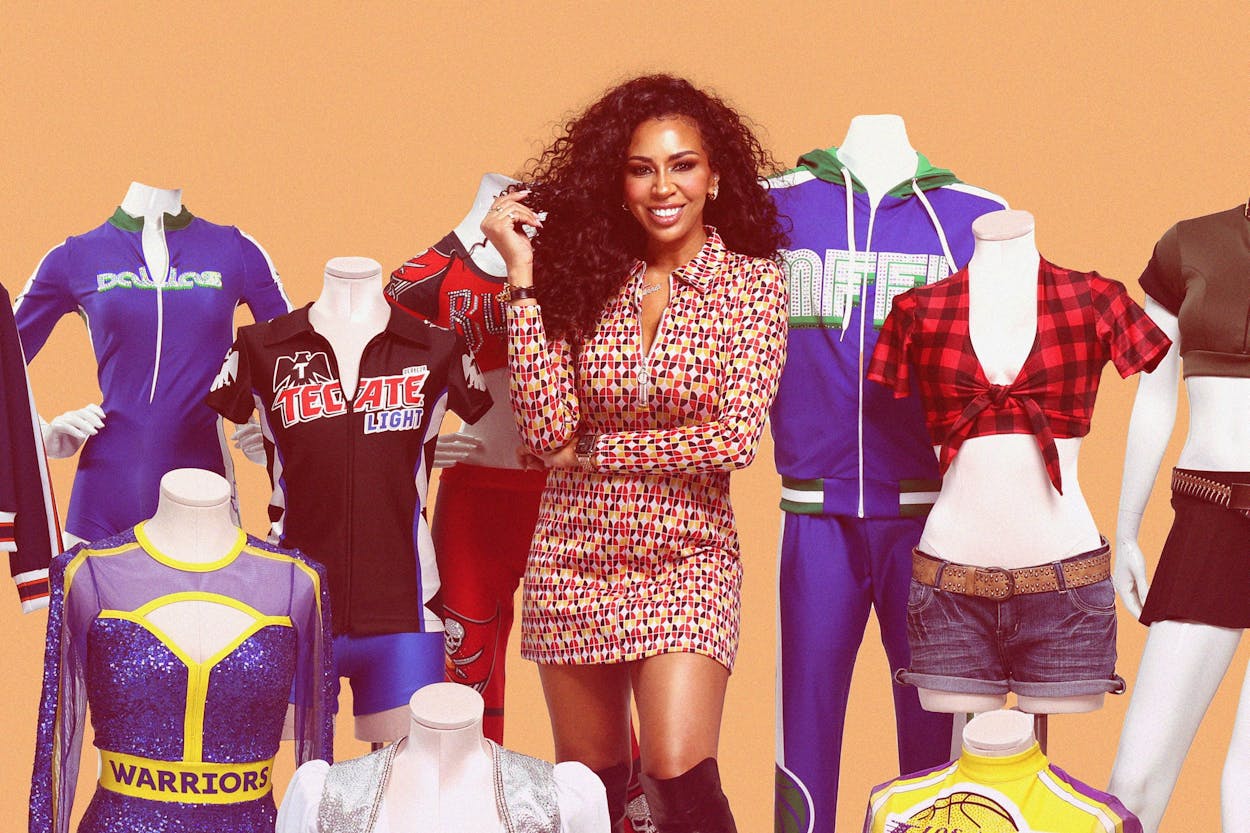Uniforms, short on fabric and tight on fit, worn by attractive young women, are one of the reasons why brands such as Southwest Airlines and Twin Peaks feel so Texan. America’s sweethearts made crop tops and hot pants as much a part of the state’s identity as cowboy hats and boots. And if you were a woman wearing one of those uniforms to cheer for four hours, or wait tables for eight, wouldn’t you want it to be as comfortable as a broken-in pair of boots, as sturdy as Carhartts or Dickies?
Designer—and Dallas Cowboys Cheerleader from 1995–2000—Terra Saunders wants that cheerleader or server to be able to bend, jump, reach, stretch, and twist without having to constantly readjust her outfit (or her body parts) to make sure she stays attractively covered. As the owner of two fashion brands, Dallaswear Uniforms and Waitressville Uniforms, she makes sure that booty shorts, crop tops, and minidresses are as durable as work-wear items that don’t reveal midriffs. Her wares are manufactured in a Dallas factory just beyond the LBJ Freeway, where thirty workers put together the sequins and spandex for NFL and NBA squads all over the country, as well as the server outfits for breastaurant brands, including Texas’s own chains Bombshells and Twin Peaks.
Saunders’s first sewing effort was to make herself a bonnet like Laura’s on Little House on the Prairie, she says. Later, she fell in love with the glitz of the Bob Mackie gowns she saw while watching reruns of The Carol Burnett Show and The Sonny & Cher Comedy Hour. “You put those [elaborate costumes] on, it’s like a wedding gown, right? Or my Dallas Cowboy cheerleader uniform. You’re a whole different girl, and that is something every woman can relate to whether they have a cool uniform or not,” she tells me.
It was the idea of a “cool uniform” that put Saunders on the path to athletic glamour. As an only child and one of the only Black students at her Plano school, she’d see kids playing soccer or performing on cheer squads and long to have the kind of belonging it looked as though a uniform could bestow. But with a single mom who was busy working multiple jobs, Saunders only spent one season on a high school drill team.
“I spent most of my time alone, sewing, drawing, concentrating, and I developed this world around me of, ‘When I can do something cool, I’m gonna get a uniform, and I’m gonna be a part of something that’s the best,’ ” she says. “Hence why I tried out to be a Dallas Cowboys cheerleader.” Twenty-plus years after her tenure, Saunders still possesses the big hair, big smile, and traffic-stopping looks that, along with incredible tenacity, were required to land a spot on the squad. And her experience enabled her to negotiate the conflicts of being professionally sexy while remaining G-rated and performing physically demanding work.
She made her own outfit for her successful audition, left Stephen F. Austin State University to return to the Dallas area, and soon was making workout leotards for fellow cheerleaders. “It started in my three-hundred-square-foot studio apartment, which was barely an apartment. I mean, I had a bed and a hot plate. And then I just started on the floor with one machine, and I made my patterns out of kraft paper.”
She built the businesses all on her own, with no outside investors. Dallaswear took off in 2008, when Saunders successfully pitched uniforms to the Oklahoma City Thunder dancers in their first season. Her company now makes uniforms for the Las Vegas Raiderettes, the Golden State Warrior Girls, the Seahawks Dancers, and scores of other cheerleading squads, but her bread and butter is Waitressville.
“There are [thousands of] Twin Peaks girls, and millions of waitresses with lots of turnover, and that’s a lot more people that we need to make look good and feel great,” Saunders says. Back in 2006, when she sketched out the first uniform for Twin Peaks cofounder Randy DeWitt, she exponentially increased her market share, and she rode the breastaurant boom through the mid-teens. All the biggest names in boobs are customers. No less a Texas icon than Megan Thee Stallion has worn Waitressville at work; in the summer of 2020, the rapper posted a throwback photo of herself in the uniform worn by servers at Bombshells.
Having spent time as a server herself, Saunders knows exactly how it feels to be assigned an uncomfortable skimpy uniform. (Holding her hands in front of her, fingers and thumbs together, she pantomimes a boss handing her a tiny outfit.) The sexy outfits that businesses ask Saunders to make are often brainchildren of male executives.
Take, for example, the initial ask that resulted in the Waitressville Dream Corset. Cocktail servers in casinos were given corsets to wear as tops. Corsets are supposed to push up your breasts and nip in your waist, and they’re also reputed to have made Victorian ladies faint from the lack of oxygen. “That boning and the construction of that is not something that is meant to be worn for an eight-hour shift, but how would a guy know that? So of course you pick this uniform—it looks good and that’s all it matters. But that is not all that matters to me,” Saunders says.

She replaced poky boning with flexible support, lacing with a solid back, and delicate straps with sturdy, adjustable shoulder straps. The result is as if someone took a piece of lingerie and gave it the durability of a sports bra and the support of a compression garment, without losing any of its figure-flattering aspects. It has an easy-on zip front and stretch-fabric panels, and it’s worn by servers working in casinos, doing bottle service in nightclub VIP sections, and serving drinks in upscale strip clubs.
While both cheerleaders and servers in booty shorts walk a fine line between expressing confident sexuality and reinforcing traditional gender and body norms, there’s no arguing that they share a common lineage with modern topless dancers. While they deal with varying levels of stigma and regulation, everyone’s an equal in the eyes of Waitressville. “We don’t see, like, Twin Peaks up here and then gentlemen’s clubs are down here,” says Saunders. “We want to elevate every single woman that’s wearing this stuff. Whether it’s the Ritz or the Men’s Club or Caesar’s Palace, they’re all clients and they’re all great and we want them all to look beautiful.” Not all the uniforms Waitressville makes are the sexiest ones; some are just very cute fitted dresses and tops. And the sizing is more expansive than it was ten years ago, though the Dream Corset tops out at a 2XL for a 43-inch bust.
Saunders teases big changes coming up for her businesses, with a rebrand impending. That’s likely going to have something to do with changes in the cheer business, as dance squads have become increasingly coed. In addition, the bodies Saunders is making uniforms for aren’t in the same cookie-cutter molds of those from thirty years ago. She says that post–Me Too, things have changed. And it’s well known that NFL cheerleaders have been pushing for better working conditions and pay.
The difference between how the hidebound NFL and the more socially progressive NBA have handled cultural change shows up in their cheer squads, with the latter league moving to have coed, age-diverse squads much more quickly. “We had to make some super-duper changes about, like, ‘All right, we’ve got people spinning on their head; now we’ve got bodies of all sizes,’ ” Saunders says.
There are a lot of threads to weave together when your core customers are businesses based on some of the most tenaciously traditional gender presentations in society, in some of the most conservative business sectors. When it comes to discussing the potential tensions between the best interests of those who wear (and make) the uniforms and those who own the businesses, Saunders says she prefers actions to words. Her actions include developing a diverse factory that depends on women all the way through. (She says there’s only one straight, white male in the entire business, her CFO and spouse, Paul.) The seamstresses who work for her include immigrants who learned sewing skills from Chinese, Mexican, and Vietnamese parents, many of whom are mothers supporting families themselves. She hires interns who might never have had role models who look like them. “I employ interns that come and work for us; I pass on my knowledge and my trade to young women, to young Black women.”
For the last couple of weeks, she’s been busy nonstop with audition season and preparing for the coming changes. To her, it’s all about making sure everyone feels like they have a team.
- More About:
- Style & Design
- Business
- Fashion
- Dallas Cowboys Cheerleaders
- Dallas






